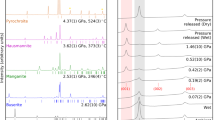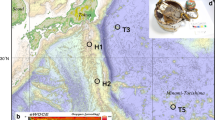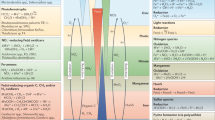Abstract
ALTHOUGH various models have been proposed to explain the origin of manganese nodules (see Goldberg and Arrhenius1), two major hypotheses have received extensive attention. One concept suggests that manganese nodules form as the result of interaction between submarine volcanic products and sea water2,3. The common association of manganese nodules with volcanic materials constitutes the main evidence for this theory. The second theory involves a direct inorganic precipitation of manganese from sea water. Goldberg and Arrhenius1 view this process as the oxidation of divalent manganese to tetravalent manganese by oxygen under the catalytic action of particulate iron hydroxides. Manganese accumulation by the Goldberg and Arrhenius theory would be a relatively slow and comparatively steady process, whereas Bonatti and Nayudu3 believe manganese nodule formation takes place subsequent to the eruption of submarine volcanoes by the acidic leaching of lava.
This is a preview of subscription content, access via your institution
Access options
Subscribe to this journal
Receive 51 print issues and online access
$199.00 per year
only $3.90 per issue
Buy this article
- Purchase on Springer Link
- Instant access to full article PDF
Prices may be subject to local taxes which are calculated during checkout
Similar content being viewed by others
References
Goldberg, E. D., and Arrhenius, G. O. S., Geochim. Cosmochim. Acta, 13, 153 (1958).
Murray, J., and Renard, A., Challenger Reports, 525, (1891).
Bonatti, E., and Nayudu, Y. R., Amer. J. Sci., 263, 17 (1965).
Pettersson, H., Inst. Medd., 2B, 1 (1943).
Buttlar, H.von, and Houtermans, F. G., Naturwissenschaften, 37, 1 (1950).
Goldberg, E. D., Submarine Geology (edit. by Shepard, F.) (Harper and Row, New York, 1963).
Goldberg, E. D., Oceanography (edit. by Sears, M.) (Amer. Assoc. Adv. Sci., Washington, D.C., 1961).
Bender, M. L., Ku, T., and Broecker, W. S., Science, 151, 325 (1966).
Goldberg, E. D., and Koide, M., Geochim. Cosmochim. Acta, 26, 417 (1962).
Korkish, J., and Hazan, I., Anal. Chem., 36, 2464 (1964).
Nikolayev, D. S., and Yefimova, E. I., Geokhimiya, 1963, 678 (1963).
Koide, M., and Goldberg, E. D., Progress in Oceanography, 3, 173 (1965).
Somayajulu, B. L. K., and Goldberg, E. D., Earth Plan. Sci. Lett., 1, 102 (1966).
Peterson, M. N. A., Murthy, V. R., and Evernden, J. F., Abstract Forty-fifth Meeting American Geophysical Union, 115 (1964).
Peterson, M. N. A., and Goldberg, E. D., J. Geophys. Res., 67, 3477 (1962).
Author information
Authors and Affiliations
Rights and permissions
About this article
Cite this article
BARNES, S., DYMOND, J. Rates of Accumulation of Ferro-manganese Nodules. Nature 213, 1218–1219 (1967). https://doi.org/10.1038/2131218a0
Received:
Issue Date:
DOI: https://doi.org/10.1038/2131218a0
This article is cited by
-
Alpha radiation from polymetallic nodules and potential health risks from deep-sea mining
Scientific Reports (2023)
-
Variations of element distribution in ferromanganese nodules and its bearing on growth rates
Mineralium Deposita (1989)
-
Some experimental data on the precipitation and migration of manganese on the seafloor
Archiv für Meteorologie, Geophysik und Bioklimatologie Serie A (1979)
-
Growth rate of manganese nodule measured with 10Be and 26Al
Nature (1978)
-
Aluminium-26 in a manganese nodule
Nature (1976)
Comments
By submitting a comment you agree to abide by our Terms and Community Guidelines. If you find something abusive or that does not comply with our terms or guidelines please flag it as inappropriate.



